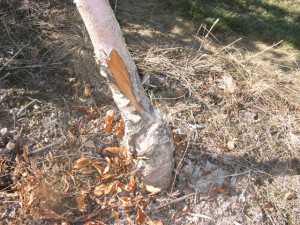Southwest Crop Injury: An After-Effect Of A Cold Winter

This young tree trunk was damaged by cold weather. (Photo credit: Tim Smith, Washington State University)
As predicted by the Farmer’s Almanac, the winter of 2014 proved to be a season of cold temperatures and large amounts of snow throughout much of the U.S. Greg Peck, assistant professor of horticulture at Virginia Tech University, says that after the cold and snowy winter he is hearing reports of young trees being hit with Southwest injury.
Southwest injury is a winter scald that develops on the south or southwest sides of the tree trunk and lower branches, with a quick temperature plummet, says Maurice Ogutu, Extension educator at University of Illinois at Urbana-Champaign. The sunny side of the trunk thaws, while the shady side of the tree remains frozen, which may lead to cracking of the bark, leaving the woody part of the stem exposed. Canker may develop at the wound site.
The Freeze Of 2010
While Southwest injury may be a new headache this spring for Eastern growers, Tim Smith, regional Extension specialist with Washington State University, says growers in Washington are still dealing with the after-effects of a 2010 deep freeze. Smith says temperatures in late November 2010 plummeted from an average of 55°F to -8°F to -10°F in a matter of a few days.
“The trees were not ready for it, the trunks are the last thing to get hardy in the fall,” Smith says. “We had extensive damage that appeared the next spring in the form of browning in the cambium layer or outright death of the cambium layer. There were all levels of browning. Some trees died right away, young trees that had serious trunk damage. Some trees held on for most of 2011 and then died. And then in 2012, more trees died.”
Perennial canker overtook the injured trunks and eventually the tree, Smith says.

This apple tree trunk, damaged by cold weather, is suffering from perennial canker. (Photo credit: Tim Smith, Washington State University)
“That polished off more trees and that’s what we’re still going through four years later,” he says. “We’re having a continual die-off in the spots that got colder caused by these fungi that attacked the damaged trunks.”
What You Should — Or Shouldn’t — Do
“One thing they can’t do is fix it by tacking down the bark,” Smith says. “The tree is physically damaged and it’s either going to heal itself or not — and many times they do. The shady side of the tree needs to have a continuous strip of cambium active and healthy. Sometimes you just get death on the sunny side of the tree which is less hardy because of the sun.”
Smith says there is a direct correlation between woolly apple aphid and the presence of canker on a tree trunk.
“Stay on top of your woolly apple aphid control to try to make it more difficult for the canker diseases to continue to re-infect the tree when every fall comes. Woolly aphid likes to attack parts of the tree that are new and fresh. That layer of growth that occurs on the edge of the killed area on the trunk is very tender and they love it,” he says. “They infest these wounded areas and re-wound that green wood that is trying to re-grow and that gives access to the fungi. You get another layer in the perennial canker that is forming.”
Not much can be done for the tree if more than one-third of the circumference of the trunk is damaged, says Deborah Breth, Lake Ontario Fruit Program Team Leader and IPM Specialist in Tree Fruit and Berries with Cornell Cooperative Extension.
Breth says, though, if the damage is less than one-third the circumference “try to cut the dead bark away using a straight linoleum cut so there is no shelter under the split bark that will attract and support the borers. The callus will be more uniform and heal that part of the trunk,” she says.
She cautions, however “There will always be the unknown with wood-rotting fungi invading the exposed heart wood.”
Smith says growers can treat the canker with fungicides or copper. However, it may not be feasible, given the long timespan that cankers may develop.
“The attack can take place over such a long period of time — spring or fall of the year following the winter damage — and then subsequent years,” he says. “It’s difficult to keep all the treatments on the tree frequently enough to make a difference on infection.”
Once a tree has sustained Southwest injury, growers may consider the need replace the damaged trees, Peck says.

On this trunk, the proliferation of crown suckers is caused by the trunk damage. (Photo credit: Tim Smith, Washington State University)
“In many cases, replanting the damaged trees is probably going to be the best decision. Nursery trees remain in short supply, so growers may not be able to obtain the cultivar and rootstock that they had originally planted in the orchard,” he says. “It might be worth trying to salvage some of the less damaged trunks by closing up the split bark.”
Peck is skeptical that bridge- and in-grafting is a good option.
“I’m getting the sense that it may not be worth the time,” he says. “It’s up to each grower to make that decision, but I’d be hesitant to say it’s an economically feasible choice for large blocks of high-density trees unless you have a talented grafter on-staff.”
Cyclical In Nature
“Every once in a while, the tree fruit industry in some region of the United States, gets hammered by winter. Then there will be a period of years after that where the secondary fungi get into weak trees and they rear up their ugly heads,” Smith says.
Prevention will likely be the best mode of action moving forward, Peck says.
“For Southwest injury (and most things in orchard systems), ‘an ounce of prevention is worth a pound of cure.’ Typically, growers in Virginia do not have to paint trunks with latex paint, but many will probably reconsider that decision in the future,” he says. “Painting trunks with a white latex paint is a fairly easy, effective, and inexpensive way to prevent Southwest injury.”
Growers should expect to see several years of tree die-off following extreme cold, Smith says.
Information for this story was gathered in interviews and from posts on the AppleCrop listserv at VirtualOrchard.net/AppleCrop.html.










